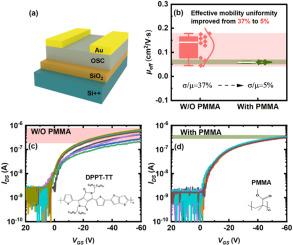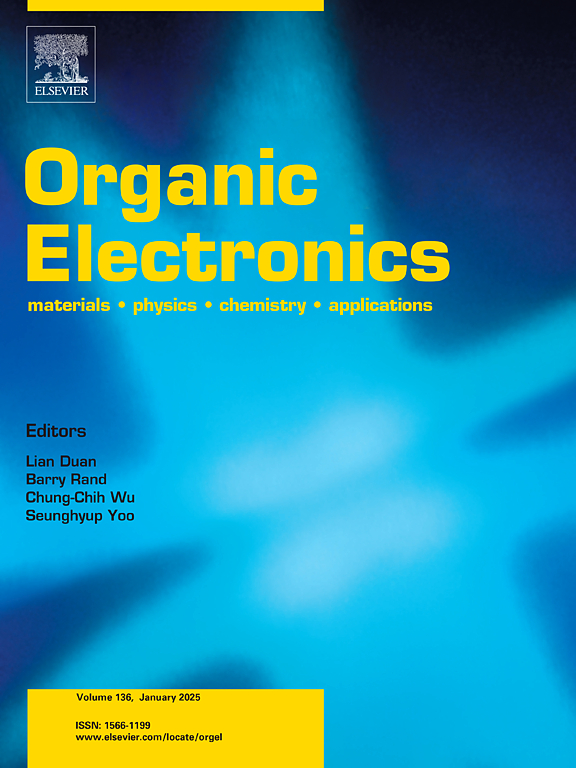通过调节排列dpt - tt: PMMA混合层的畴结构来实现均匀的电性能
IF 2.6
4区 工程技术
Q3 MATERIALS SCIENCE, MULTIDISCIPLINARY
引用次数: 0
摘要
聚合物场效应晶体管(pfet)在柔性显示器上有着重要的前景。然而,由于链取向和畴结构的变化而引起的性能不均匀性阻碍了它们的广泛应用。本文通过将Langmuir-Blodgett (LB)技术与聚甲基丙烯酸甲酯(PMMA)共混在排列共聚物dpt - tt半导体层中,优化了电均匀性。LB过程增强分子取向,增强π-π分子间相互作用。并联通道器件的导通电流达到27 μA,比正交通道器件提高了20%。加入PMMA (dpt - tt:PMMA = 1:0.4)优化膜形态后,膜的阈值电压更为均匀,为4.3±2.1 V,而未加入PMMA的膜的阈值电压为5.5±3.4 V。同样,与6.7±1.1 V/dec相比,PMMA在6.5±0.9 V/dec时的亚阈值摆幅更加一致。含有PMMA的器件的陷阱密度为3.0 × 1012 eV−1cm−2,与不含PMMA的器件相比减少了75%。这些结果证明了制造高均匀性pfet的可扩展策略,提高了其在柔性电路中的适用性。本文章由计算机程序翻译,如有差异,请以英文原文为准。

Achieving uniform electrical performance by regulating domain structure in aligned DPPT-TT: PMMA blended layers
Polymer field-effect transistors (PFETs) hold significant promise for flexible displays. However, their widespread application is hindered by performance non-uniformity arising from vatiations in chain alignment and domain structures. This paper optimizes the electrical uniformity by integrating the Langmuir-Blodgett (LB) technique with poly (methyl-methacrylate) (PMMA) blending in aligned copolymer DPPT-TT semiconductor layers. The LB process enhances molecular orientation, strengthening π-π intermolecular interactions. The on-current of parallel-channel devices reaches 27 μA, which is a 20 % increase compared to orthogonal-channel devices. Incorporating PMMA (DPPT-TT:PMMA = 1:0.4) optimize film morphology, exhibit a more uniform threshold voltage of 4.3 ± 2.1 V, compared to 5.5 ± 3.4 V for those without PMMA. Similarly, the sub-threshold swing is more consistent at 6.5 ± 0.9 V/dec with PMMA, versus 6.7 ± 1.1 V/dec without it. The trap density of devices with PMMA is 3.0 × 1012 eV−1cm−2, which is a 75 % reduction compared to devices without PMMA. These results demonstrate a scalable strategy for fabricating high-uniformity PFETs, advancing their applicability in flexible circuits.
求助全文
通过发布文献求助,成功后即可免费获取论文全文。
去求助
来源期刊

Organic Electronics
工程技术-材料科学:综合
CiteScore
6.60
自引率
6.20%
发文量
238
审稿时长
44 days
期刊介绍:
Organic Electronics is a journal whose primary interdisciplinary focus is on materials and phenomena related to organic devices such as light emitting diodes, thin film transistors, photovoltaic cells, sensors, memories, etc.
Papers suitable for publication in this journal cover such topics as photoconductive and electronic properties of organic materials, thin film structures and characterization in the context of organic devices, charge and exciton transport, organic electronic and optoelectronic devices.
 求助内容:
求助内容: 应助结果提醒方式:
应助结果提醒方式:


